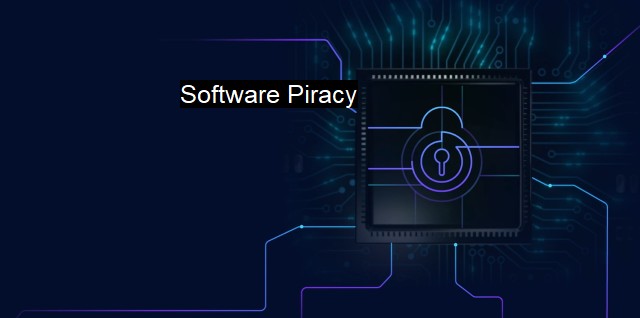What is Software Piracy?
The Perils of Software Piracy: Threats to Cybersecurity and Intellectual Property Rights
Software Piracy refers to the unauthorized reproduction or use of someone else's copyright protected software. It is an illicit activity as it violates copyright laws. In this context, piracy is, not sport, but criminal activity, which poses significant risks to businesses, individuals, and creators. Besides ethical issues, software piracy raises serious cybersecurity concerns.Software piracy comes in different forms. The most common types include End-User Piracy, Client-Server Overuse, Internet Piracy, Hard-Disk loading, and Software Counterfeiting. End-User Piracy involves an individual copying software without the developer's permission. This often involves sharing a software with friends, colleagues, or using a single license in multiple computers, which is against most software agreements.
Client-Server Overuse occurs when more users are on a server than the license allows. For instance, a software might allow five users to be on the server simultaneously, but seven people are using it, thus two users pay no licence fee. Internet Piracy involves sharing download links and activation keys online in forums, emails, and social media.
Hard-Disk Loading involves a computer retailer installing an unauthorized copy of software on the disk for the purpose of making a computer package more attractive. Software Counterfeiting is manufacturing counterfeit copies of software and its packaging, usually to replicate some well-known software, selling it as legitimate.
Software piracy is closely tied to cybersecurity because pirated software often lacks the safeguards of legitimate software, making it much more vulnerable to cyberattacks. For instance, pirated software may not have access to regular security updates and patches, resulting in weaknesses that can be exploited by malicious software such as viruses, worm, or spyware. it becomes easier for hackers to gain unauthorized access and possibly steal sensitive data.
Pirated software often includes malicious code embedded by the hackers who distribute it. It may come with inherent malfunctions making the software or the hardware it was installed to, operational defective. Visual irregularities, system crashes, slow processes, lost files, are common symptoms of a harmful underlying code in pirated software.
Safeguarding a system that runs pirated software can be an insurmountable task given the increased exposure to threats. Using legitimate software and obtaining licenses legally ensure you gain access to critical security updates. These are protective measures released by software developers to seal any potential vulnerabilities within the software. Delayed or differed patches, a practice called "patch floating", might expose the system further to malware breaches.
Relevant antivirus software plays a critical role in handling existing threats within a system. It's best to install antivirus software from trustworthy sources for real-time protection and regular updates. Antivirus software scans systems for known malicious patterns, isolating, and deleting threats before they harm the system. This is especially critical given the ever-evolving nature of cyber threats.
The presence of good antivirus software can significantly mitigate the risks associated with software piracy. the most effective guard against the menaces of piracy is keener awareness and strict adherence to copyright laws. Organizations and individuals should make efforts to use licensed software to protect their data and systems while upholding the rights of software creators.
Software piracy is not just against the law but poses significant cybersecurity risks to its practitioners, while adversely affecting content creators. Being aware of this and resorting to legal software acquisition ensures everyone benefits: the protected systems, balanced playfield for developers, and a healthy technology ecosystem in general. It's, therefore, imperative that IP laws be tightened and judicial systems around the world be well equipped to deal the penalties to the violators so that the cyberspace can be a safe place.

Software Piracy FAQs
What is software piracy?
Software piracy is the unauthorized use, distribution, or reproduction of copyrighted software without the permission of the owner. It is a form of intellectual property theft and a violation of copyright laws.What are some consequences of software piracy?
There are several consequences of software piracy, such as legal consequences, financial losses to the software owners, and increased cybersecurity risks to users. Pirates may face hefty fines and even prison sentences. Pirated software is also more likely to contain malware and other viruses, which can infect users' devices and compromise their security.How can I avoid software piracy?
You can avoid software piracy by purchasing licensed software from authorized resellers or directly from the software owners. You should also avoid downloading software from unauthorized sources, such as peer-to-peer sharing networks or illegitimate websites. It is also important to regularly update your antivirus software to safeguard against potential security threats.What are some ways to report software piracy?
There are several ways to report software piracy, including contacting the software owners or their authorized resellers, reporting to law enforcement agencies, or filing a complaint with industry associations or authorities. Software owners also often have online portals for reporting piracy, which can be found on their official websites.| | A | | | B | | | C | | | D | | | E | | | F | | | G | | | H | | | I | | | J | | | K | | | L | | | M | |
| | N | | | O | | | P | | | Q | | | R | | | S | | | T | | | U | | | V | | | W | | | X | | | Y | | | Z | |
| | 1 | | | 2 | | | 3 | | | 4 | | | 7 | | | 8 | | |||||||